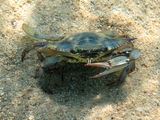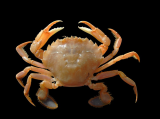Decanet taxon details
Uroptychus pollostadelphus Baba, 2018
1298948 (urn:lsid:marinespecies.org:taxname:1298948)
accepted
Species
marine, brackish, fresh, terrestrial
recent only
Baba, K. (2018). Chirostylidae of the Western and Central Pacific: <i>Uroptychus</i> and a new genus (Crustacea: Decapoda: Anomura). In: Tropical Deep-Sea Benthos 30. <em>Muséum national d'Histoire naturelle, Paris.</em> 1-612. [details] Available for editors 
Type locality contained in New Caledonian Exclusive Economic Zone
type locality contained in New Caledonian Exclusive Economic Zone [details]
Depth range Deep-sea context derived from a specimen depth data search
Etymology From the Greek pollostos (smallest) plus adelphos (twin), alluding to a pair of very small epigastric spines.
Depth range Deep-sea context derived from a specimen depth data search [details]
Etymology From the Greek pollostos (smallest) plus adelphos (twin), alluding to a pair of very small epigastric spines.
Etymology From the Greek pollostos (smallest) plus adelphos (twin), alluding to a pair of very small epigastric spines. [details]
DecaNet eds. (2025). DecaNet. Uroptychus pollostadelphus Baba, 2018. Accessed at: https://decanet.info/aphia.php/aphia.php?p=taxdetails&id=1298948 on 2025-09-12
Date
action
by
original description
Baba, K. (2018). Chirostylidae of the Western and Central Pacific: <i>Uroptychus</i> and a new genus (Crustacea: Decapoda: Anomura). In: Tropical Deep-Sea Benthos 30. <em>Muséum national d'Histoire naturelle, Paris.</em> 1-612. [details] Available for editors 
context source (Deepsea) Baba, K. (2018). Chirostylidae of the Western and Central Pacific: <i>Uroptychus</i> and a new genus (Crustacea: Decapoda: Anomura). In: Tropical Deep-Sea Benthos 30. <em>Muséum national d'Histoire naturelle, Paris.</em> 1-612. [details] Available for editors
context source (Deepsea) Baba, K. (2018). Chirostylidae of the Western and Central Pacific: <i>Uroptychus</i> and a new genus (Crustacea: Decapoda: Anomura). In: Tropical Deep-Sea Benthos 30. <em>Muséum national d'Histoire naturelle, Paris.</em> 1-612. [details] Available for editors
 Present
Present  Inaccurate
Inaccurate  Introduced: alien
Introduced: alien  Containing type locality
Containing type locality



